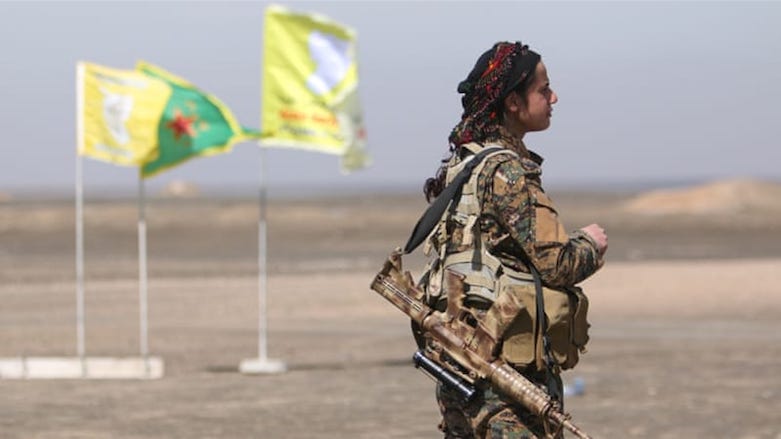SDF Operations in October Capture 79 ISIS Militants Across Western Kurdistan
The SDF arrested 79 ISIS militants in October through six operations across northern and eastern Syria, including two senior commanders. This brings their 2025 total to 175 arrests amid warnings of ISIS resurgence following US troop reductions.

ERBIL (Kurdistan 24) – The Syrian Democratic Forces (SDF) and the Internal Security Forces (Asayish) continued their joint counterterrorism operations throughout northern and eastern Syria (Western Kurdistan) in October, targeting ISIS sleeper cells as the group seeks to reassert itself in the power vacuum left by reduced U.S. presence.
According to data compiled by the SDF’s coordination office, six separate operations were conducted during the month, resulting in the arrest of 79 ISIS members, including two senior commanders.
Breakdown of the October operations
October 1: In Tikehi, east of Deir ez-Zor, SDF units raided ISIS hideouts, arresting three militants and seizing weapons and documents proving their affiliation with the organization.
October 5: In the Ayn Issa countryside, particularly around Hisha, the SDF and Asayish launched a large-scale joint operation. The offensive led to the arrest of 71 ISIS members and the confiscation of a significant cache of arms.
October 16: Backed by the International Coalition, SDF commando units carried out two operations in the eastern countryside of Deir ez-Zor. One militant was captured in Bariha village, and two others were detained in Sebha.
October 21: The SDF Military Operations Teams (MOT), again with coalition air support, arrested an ISIS commander identified as Ahmed Abdulqadir al-Mousa in Tabqa city. Al-Mousa was reportedly responsible for coordinating attacks on SDF positions.
October 23: Another MOT-led operation in Maskaneh, east of Aleppo, resulted in the arrest of a senior operative named Ahmed Khalaf al-Hussein.
In total, six operations across the month led to 79 arrests, including two top commanders, marking one of the most active months of SDF counterterrorism activity this year.
Since the beginning of 2025, the SDF and Asayish have conducted 76 operations, neutralizing two high-level ISIS leaders, killing seven militants, and detaining 175 others, according to official figures.
The renewed wave of operations comes as ISIS intensifies its activities across eastern Syria, particularly in Deir ez-Zor province, where the group has rebuilt its presence through small, decentralized cells.
A recent Wall Street Journal report described the resurgence as a direct consequence of the U.S. troop drawdown and the collapse of the Assad regime’s remaining military structures, which allowed ISIS fighters to seize abandoned weapons and expand their reach.
Commanders from the SDF told the newspaper that ISIS has staged at least 117 attacks in northeast Syria through the end of August—far surpassing the 73 attacks recorded in all of 2024. These include ambushes, assassinations, and roadside bombings targeting SDF patrols and local officials.
The militants’ tactics have evolved: they now operate in sleeper cells of four to five members, blending into local Sunni communities and relying on hit-and-run assaults. Civilians have reported rising cases of extortion and intimidation, particularly in oil-producing areas like Diban and Hajin.
SDF officials acknowledge that maintaining stability across such a vast territory—while also guarding detention facilities holding tens of thousands of former ISIS fighters and their families—has stretched their capabilities thin.
“The withdrawal of American forces is inspiring Daesh,” said Goran Tel Tamir, a senior SDF commander in Deir ez-Zor. “We are seeing more attacks, and people are increasingly afraid. The security gap is growing.”
The U.S.-led coalition continues to provide intelligence and aerial support, but SDF officers note that the absence of American patrols has emboldened ISIS operatives. Former coalition bases in the desert now stand empty, leaving the Kurdish-led forces to shoulder the burden of daily counterterrorism operations.
While the SDF remains committed to containing the threat, officials warn that the group’s resurgence could jeopardize regional stability. ISIS no longer controls territory, but its ability to strike unpredictably across Deir ez-Zor, Raqqa, and Aleppo provinces underscores the fragility of the post-war landscape.
For the SDF and their partners, October’s results—79 militants captured, including key figures—represent a tactical success. Yet as commanders acknowledge, without sustained international support and a stable governance structure in Syria, the fight against ISIS remains far from over.
